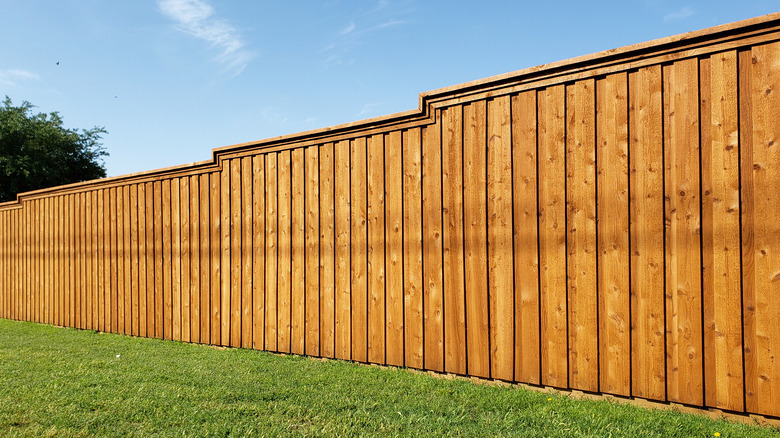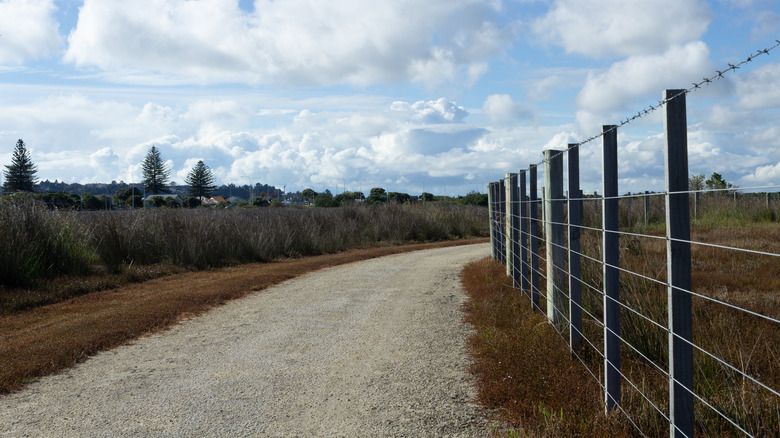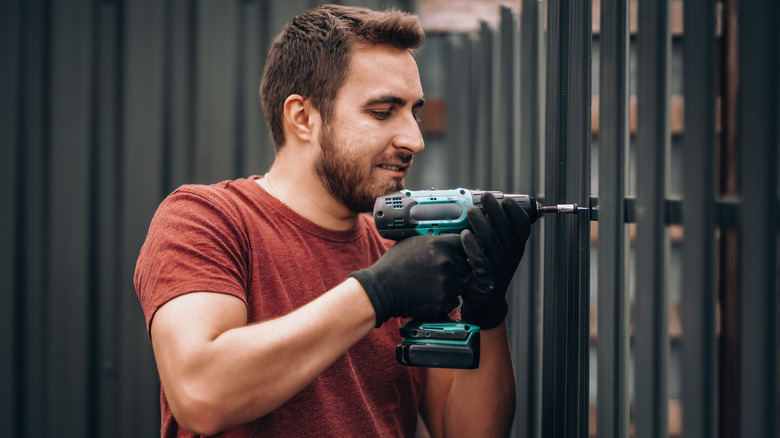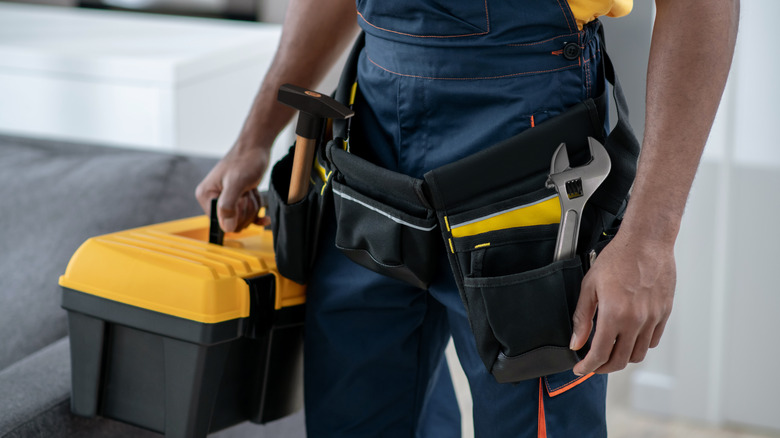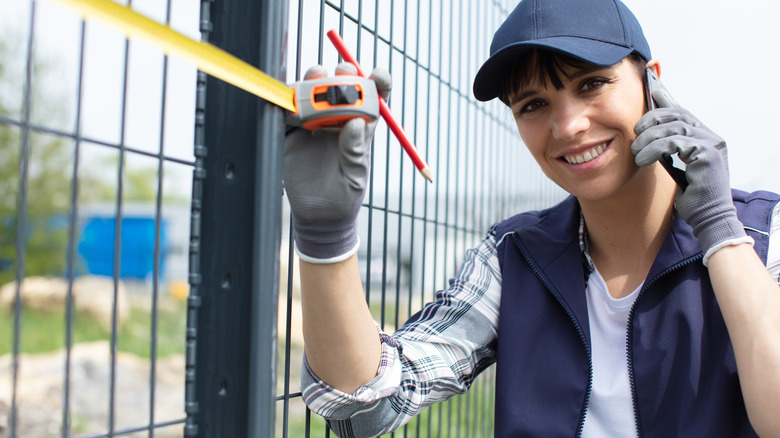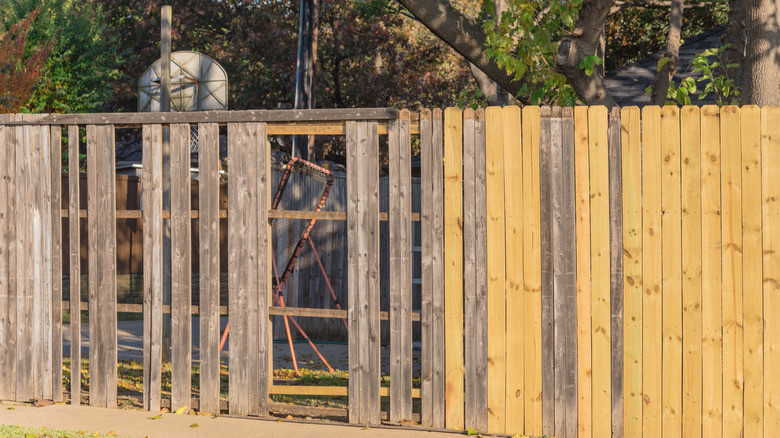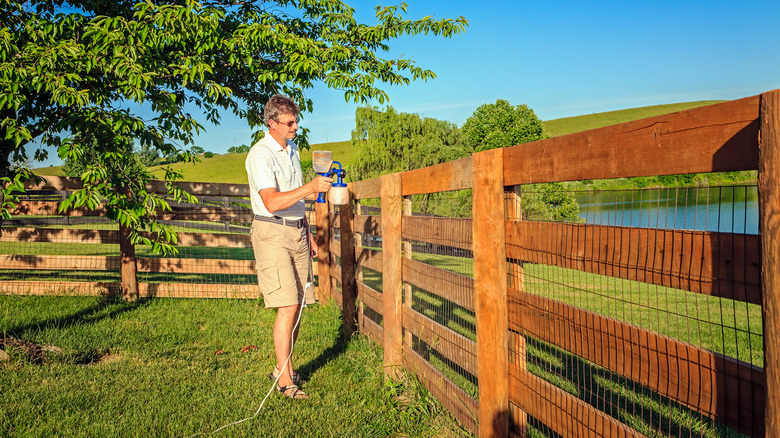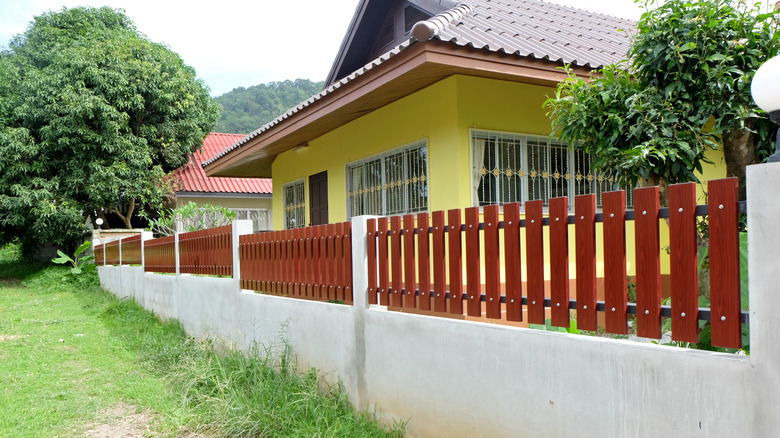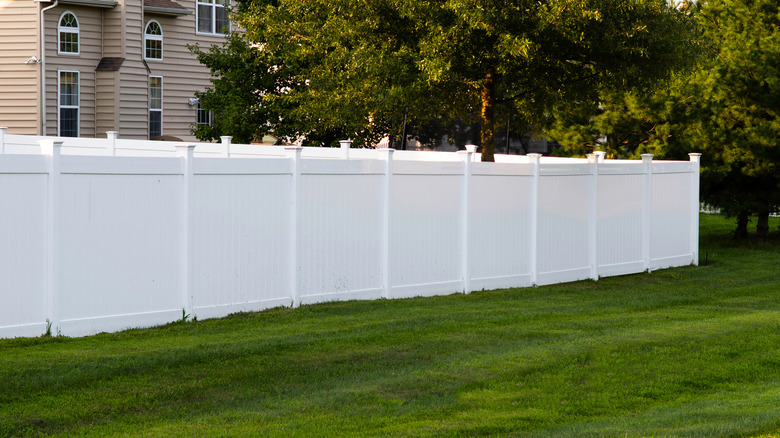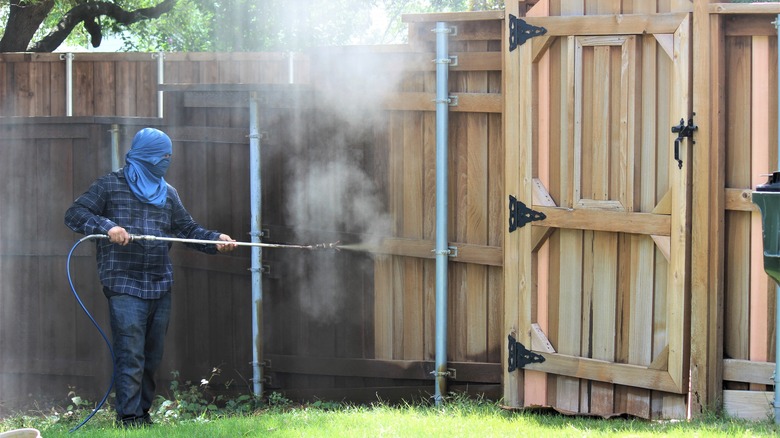Mistakes Everyone Makes When Buying A New Fence
Many homeowners have a fence in their backyard. Whether this is for security or privacy is up to the homeowner. Thinking of buying a new fence? Remember that building a fence requires a good amount of time, money budgeting, and intricate planning. Rio Grande Fence Co. advises going over legal restrictions to make sure the fence isn't impeding on neighbor's property lines and follows HOA standards. Before beginning on the fence project, make sure to measure the backyard properly, and keep in mind that posts need to be set with cement or gravel.
Fencing contractors need to be insured as well as part of a reputable company. Make sure the fencing company will call back and they'll finish the job they first began. Always come with questions and be direct about specific needs and wants when purchasing a fence. When it comes to fencing, be sure to consider these mistakes homeowners tend to make.
Not reading over legal and zoning regulations
Before building a fence, a major mistake homeowners make is not considering legal restrictions. You may need a permit from your city or county to build a fence, according to Rocket Homes. It depends on what state a homeowner lives in as to whether they need a permit or not. Some states don't require them, but those that do could fine or sue homeowners that build a fence without first obtaining legal permission. The local government at city or county level will have regulations that homeowners need to follow such as property line regulations and the maximum height of the fence.
In some areas, fences that are under six feet tall may not require a permit (via The Spruce). There are communities that aren't in favor of tall fences around subdivisions because they feel it's a distraction to onlookers and may seem like an eyesore. Barbed wire or electric fences may only be allowed in industrial zones in large cities. On the contrary, rural areas may allow more leeway for barbed wire, chain link, and electric fences due to farming and other agricultural industries.
Paying too much for a new fence
When buying a new fence, think of a budget to stay within, and do your research so you'll know how much you can expect to pay. How much should a new fence cost? Home Depot advises that the average cost to install a fence from their company is over $4,000. There is no exact price for fence installation, but purchasing a fence that will be built around a large yard is more expensive than working with small yards.
Cost is also dependent on the style of fence and any additional design add-ons. For instance, wooden fences cost more and need more care. Uneven or rocky land may require higher expenses due to complicated layouts and removal tactics. Cost varies state by state, so be sure to consider that when purchasing a new fence.
A backyard that has a slope in the land may require special measuring and building techniques, as stated by Bob Vila. Since it takes time and labor, removing old fencing also comes at a cost as well. Adding in gates and locks could be expensive, especially a drive-through gate versus paying for a walk-through gate. The best bet is to shop around for suitable prices before going for a quote.
Not talking to neighbors about installing a new fence
Before building a new fence, it's good neighbor etiquette to tell next door neighbors about your upcoming project, especially if part of the new fence will be shared with the neighbor. If a completely new fence is built on the neighbor's property, it may need to be moved, according to Freedom Fence & Railing. When putting up the new fence, have the good side of the fence face outwards towards the neighbors. Aluminum and vinyl fences look about the same front to back, but wood fences have one side that is unfinished. Keep the unfinished side facing inward towards the lawn. Like always, make sure to keep the new fence in stellar shape by using a garden hose and soap to wash down any mud or dirt stains.
Find Law reminded homeowners to be aware of neighbors who don't comply with homeowner's associations regulations as far as fence height and materials are concerned. Neighbors who break the subdivision's rules may be in violation with the city and could receive a warning letter. Every neighborhood has its own rules, so be sure to get the okay before building a fence of a particular preference, especially if two neighbors share a side.
Installing the fence without professional help
While there are homeowners who are crafty enough to build their own fences, most people need professional assistance when constructing their fencing project. Usually, the best bet is to contact fencing companies, getting quotes from contractors, landscapers, and handymen are other ways of receiving professional input (via The Spruce). The fencing company should carry insurance as well as workers' compensation and liability as well as have no pending lawsuits.
Want to have a fence like the rest of the neighborhood? Ask around to see what companies neighbors went with to build their fences. Research online to see what pricing estimates are the best when building and purchasing a new fence. Have a fence company representative come over to survey the land to see what's most conducive to the layout of the property and costs. Be sure to keep children and dogs inside and gates unlocked for easy access in and out when this occurs.
Not checking out the reputation of your fence installer
Not all professional fencing companies are the same, but it's the homeowner's responsibility to make sure the company they're working with is reputable and has positive customer reviews. Home Advisor suggested to ask questions about the business's reputation and history. A fencing company that has been around for a long time and been successful will perform quality work. Ask to see a portfolio with a physical copy of the company's work, or check out the company's social media page for examples. Take not of how long the company takes on average to complete a project. Before building a new fence, a deposit may need to be paid up front for materials. Other companies may want the money once the project is completed. Make sure to look over a written contract closely and thoroughly before signing.
Fencing contractors often become qualified by attending trade schools, according to Forbes. Fencing contractors receive hands-on training and complete coursework. Each state has its own rules regarding licensing requirements. Some states have a Certified Fence Contractor (CFC) designation that remains valid for three years.
Having poor quality materials
To build a new fence, people need to make sure they have the right tools to begin the project as well as for making any adjustments once the fence is up. Doing everything by hand without tools or going blindly into the project without proper tools could cause serious damages and create a crooked fence. According to Power Fence Supply, there are some basic tools and items that need to be used while building a new fence. Find a wheelbarrow to carry away old shrubs and branches as well as dirt for composting. To prevent getting callouses or cuts on hands, buy inexpensive work gloves. Find a post digger to dig holes in the ground. By using this tool, the holes are sized more precisely. A digging bar works even better.
Have a toolbox lying around? It helps to have tools such as hammers, screwdrivers, wire cutters, and pliers on hand to make minor adjustments to the fence. Circular saws could be used to cut and trim any imperfections on the fence, if you're installing a wooden fence. Vinyl fences are easy to build, according to Utah Fence Warehouse, though you'll need different tools to do the job, such as a vinyl notching tool and vinyl nail remover.
The measurements are off
When building a fence, it's vital to measure accurately and make sure posts are evenly spaced between each other. Start by marking the four corners of the yard with stakes. Mark where the posts would be situated no more than 8 feet apart. String could be used to measure corners, but measuring tape is more accurate. Make sure the corners are squared before continuing the length of the fence.
If measurements are off, the fence may be encroaching on a neighbor's property line, warns Long Fence. It's proper neighbor etiquette to speak with the neighbor before building to keep property lines separated. The fence shouldn't be built on gas, electric, or cable lines. Have a fencing company check to see if there are any lines underground to keep the new fence away from them. More material may be needed if there's a slope to the terrain of the property.
The posts are damaged due to improper placement and care
As time goes by, fences may start deteriorating due to adverse weather conditions, or because posts were placed into the ground improperly. Posts need to be set in the ground sturdily before continuing the new fence project. With posts that need to be repaired, check to see if a certain post or the whole fence needs to be removed, advises Bob Vila. If the damage isn't too bad and the post is still structurally-sound, repairing it is a good way to go. For simple fence post repairs, buy a fence patch kit that could fix small holes and cracks. If you decide the post needs to be replaced, you'll want to be sure to have a new fence post on hand, as well as the proper tools to make the adjustment.
Selecting the right kind of fence wood may prevent post damage and breakage. It's best to select treated wood or dense "heartwood," which can hold up to the elements better then newer-growth wood (via Bob Vila). Add pea gravel or crushed stone to the bottom of fence post holes to secure placement. Repeat this process a second time for added durability. It's also a great idea to caulk the area where the fence post meets the concrete footing to cover seams. Seams could cause water to be trapped between wood and concrete, which will eventually make the posts rot.
Not taking care of wood fences properly
Wood fences are common and popular for families who live in child- and pet-friendly housing developments. Though attractive to the eye, wood fences need to be maintained by being cleaned and protected. According to HGTV, cedar and redwood are more resistant to rot and decay, and pressure-treated wood is a good option for posts, due to being treated with chemicals that combat insects, but aren't harmful to humans. These kinds of woods are labeled as being chemically treated and aren't too expensive when bought at a local home store. Wood fences should be sprayed with a wood preservative as a seal. After half a decade, wooden fences could warp or lean due to the outdoor elements, so it's best to have a protectant over the fence to combat these problems.
Florida State Fence advises that weather can damage wood fences over time, so it's best to make sure to buy wood that is durable. Black locust, white oak, red cedar, and redwood are all examples of durable quality wood. Pine, white fir, and Douglas fir aren't exceptionally durable. Wood fences that don't have any waterproofing sealant as a cover are prone to decomposing. To protect a fence by hand with a sealant, strip off old sealant with a wood stripper if needed. Apply acidic wood brightener on the fence, which neutralizes pH in wood, and apply a waterproof fence sealant or stain after cleaning the wood fence with basic soap and water.
Uncertainty about what kind of fence to buy
When buying a new fence, it may be hard to decide what fence to install. For those who favor wood, Florida State Fence prescribed building with red cedar which doesn't warp or shrink easily. If broken posts are replaced and the fence is sealed correctly, red cedar fences could last a while. Want a modern take on a new fence? Try building a vinyl fence. They're usually thicker and higher quality than wooden fences, but may require a professional to do the job since they require more skill to build. These fences are great for businesses and homes as well, especially families with children and pets.
While not the most aesthetically pleasing, chain link fences are another option, according to Patch. Chain link fences could last for years, and are affordable and durable. Live near the oceanside in a warm climate? Aluminum fences can withstand the heat and beachy elements, but may not be strong enough to protect children and animals from playing rough or getting loose. These kinds of fences may work better with older couples who are empty nesters, and they fit aesthetically with the style of older homes.
Not considering a vinyl fence
Tired of wooden fences? Why not buy a vinyl fence to put around the backyard? According to The Spruce, vinyl fences are made from polyvinyl chloride (PVC). The benefits of having a vinyl fence are that they don't require much maintenance and won't splinter the way wood does. They also don't need constant refinishing like wooden fences do, either. Though vinyl fences are a plausible choice for those who want a new fence, they do have cons. Severe weather could damage a vinyl fence and cause pieces to break off. Vinyl fences are high in cost. Algae, mold, and mildew could grow on vinyl fences and cause staining, which means they'll need to be cleaned more frequently.
Another benefit to having a vinyl fence is that they don't need to be repainted, according to All Over Fence. Vinyl fences come in a variety of colors like cream, tan, brown, and white. Brighter and bolder colors like red or blue could be used as well. Since vinyl fences are made from eco-friendly materials, they're easy to recycle and use again. Vinyl fences also offer more privacy, which is another great reason to try vinyl.
Not buying a fence secure enough for children and pets
With children and pets, finding a fence that could work for both is essential to living in comfort, safety, and peace. Reliable Fence Co. Inc. advises that the height of the fence should be tall enough to prevent children or pets from jumping over to the other side. Short fences are cute and look admirable to nearby neighbors, but tall fences provide more safety and security. Fences with gates and locks can prevent intruders from coming in and children from going out.
With big dog breeds such as German shepherds and boxers, make sure the fence is at least 6 ½ feet to 7 ½ feet tall to prevent them from climbing over a fence (via Fence-All). Small dogs aren't as much of an issue because they can't jump over fences. However, they could escape under fences that aren't lodged completely into the ground by squeezing underneath. To prevent dogs from becoming curious and escaping, build a solid panel privacy fence. Make the backyard a fun haven for dogs by having grassy and shady areas for play and rest. Bring squeaky balls outside to play catch when the occasion rises.
Not taking care of the fence after it's built
After a new fence is built, it needs to be maintained and cleaned on a regular basis to ensure longevity and stability. If the fence is vinyl, First Class Fencing recommends rinsing it with a garden hose for simple cleaning. For deep cleaning, try mixing a mild bleach cleaner with a soft brush and scrubbing the posts lightly. A power wash may do the trick as well to keep the vinyl fence clean. With wooden fences, if a stain wasn't used to preserve the wood, it could be painted a specific color to cover cracks. After being painted, a sealing solution should be covered over it. Try power washing a wooden fence with a solution made of water and vinegar.
To keep wooden fences looking good, Bronco Fence notes that you can find wood preservatives at a home store to spray over the fence. This could slow down the decaying process, but may not be as effective as having a wooden fence that's already been color-treated and protected. Make sure sprinklers are kept away from wooden fences to prevent leaning and warping. It's also a good idea to cut overhanging branches away from vinyl fences. This prevents damage especially during winter storms.
Not installing a fence at all
Oftentimes, fences are used for privacy, but does everyone need to purchase a fence? Homes are fine without them, but sometimes resale value comes from fencing. Fences enable privacy and security, according to Family Fence Company. Families could eat dinner in peace and have parties in private without the whole neighborhood watching them. Fences also dissuade intruders from breaking into the home. Building a new fence prevents intrusive sounds and sights from coming through to disturb the peace. A fence could block out the sounds of a loud, busy highway.
There are cons when installing a new fence as stated by O'Neill Landscape Group. Fences require regular maintenance and cleaning. Wood fences need to be consistently power washed and stained to keep the wood sturdy. Neighbors may not like tall privacy fences and find them to be unattractive and obstructive, hence why it's important to speak with your neighbors or your subdivision's HOA before installing a new fence. On the pro side, New Jersey Best notes that fences produce a special aesthetic that could match a home perfectly in terms of color and design.
